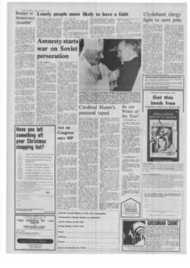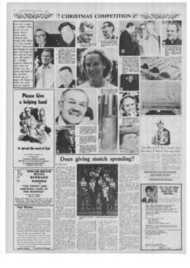Page 3, 1st December 1978
Page 3

Report an error
Noticed an error on this page?If you've noticed an error in this article please click here to report it.
Tags
Share
Related articles
Control Of York School
St Augustine's: The Catholic View
Headmaster Reiterates Opposition To Education Plans
Reports From Around Britain
Hard Decision For Bishops
The Rocky Road to York re-organisation
rather a matter of principle.
They are backed by the parish priest of St George's, Fr Thomas Burke, chairman of the St George's School board of governors, and by Mr John Hirst, who chairs the parent-teacher association.
Mr Kiely concedes that a more urgent doubt about the new school as outlined in the proposals' is the split-site feature. The school will have premises on the outskirts of the city and in the city centre.
The nuns' claim to the control of the new school lies in the part that the Bar Convent will play in the new set-up, and is being promoted by the present head teacher, Sister James.
The IBVM is investing its property in the scheme to provide accommodation for the senior section of the school. The order is paying the part of the capital costs, estimated at about £102,000. for adapting the build ings on the Bar Convent site a burden which would otherwise have fallen on the Diocesan Schools Commissions.
The Bar Grammar School is and always has been the work of the convent community, and there is such a close inter-relation between school and convent in physical terms that a total "outsider" in a head teacher's position would seem invidious and compromising.
There is so little distinction between which parts of the building are school and which are convent that classrooms are side by-side with nuns' private rooms.
The nuns of the Bar Convent have a strong following in York and are highly respected even by the vast majority of Catholics for whom the negotiations over comprehensive schooling are not an urgent concern.
In less than eight years' time, they should be able to mark 300 years work in education of Catholic children in York, and in such a historic city that weighs , heavily.
Some Catholic parents this week described their expectations for the new school in a phrase from the 1944 Education Act — parity of esteem." used in a different context.
They say that even if money were available for a new purposebuilt Catholic school which excluded the Bar Convent, parents would not be interested, and would prefer to send their children to the long-established. traditional grammar schools like Archbishop Holgate's, which are becoming part of the York county comprehensive schools.
Already, a growing number of Catholic boys attend Archbishop Holgate's and Nunthorpe schools, because there is no Catholic Grammar school provision for boys in York.
It has been pointed out by Mr Kiely of St George's that while ihe policy of utilising existing buildings tor comprehensive re organisation has been strictly applied in York, Middlesbrough has no fewer than eight new purpose-built Catholic comprehensive schools in the town.
Plans for a new school in York were talked about some years ago, and a site was acquired but not developed.
Negotiations for the changeover to comprehensive schooling have been going on for 20 years, always with the Bar Convent taken into account. Most recently, the word "convent" was dropped from the title of the grammar school and the trust deeds were altered to allow for the admission of boys. There are now three boys in the sixth form and a class of 30 boys in the first year.
The IBVM declared their intention of taking part fully in the comprehensive set-up some time ago, and signed an agreement to give up direct grant status in December, 1975.
The Bar Grammar School site has been selected as the senior section of the new comprehensive. The junior section will be based on the premises of St Margaret Clitherow School, at present a Catholic girls' secondary modern school which, like St George's, will be amalgamated.
The wisdom of this arrangement is questioned by Mr Kiely and Mr Gare. They point out the limitation on space for expansion on the central site of the Bar Convent, compared with the open space surrounding St Margaret Clitherow's.
They say the scheme is a commitment to a split-site school for good, and there can be no prospect of .eventually developing a single-site school if the Bar Convent is given such a crucial role.
Supporters of the scheme quote the conservatism of York Catholics who would be likely to prefer to send their children to a traditional county high school at 13. rather than to a Catholic high school formed from a former secondary modern, and that facilities such as science laboratories at the Bar are better for adapting to the needs of the senior section of the new school.
In a recent stormy meeting on the re-organisation, reported in the Catholic Herald, the Reverend Mother Agatha of the Bar Convent was pressed into answering whether the nuns might pull out of the York local Catholic schools system if they were not guaranteed the headship and control of the proposed comprehensive.
The possibility that they might pull out is largely academic. No one, not even the sternest critics of the proposals as they stand, appears to want or expect that. What some teachers are pressing for is greater evidence of real lay responsibility in consultation and decision-making at the start of a new educational project.
While control of the running of the new school may be a priority for some people such as Mr Gare, whose job as head teacher disappears, there is another significant element which will be under the microscope at the DES now that he proposals are being considered.
The constitution of the governing body of the new school could be a stumbling block to the proposals as a whole.
The governing body would consist of 18 members. Six of these would be appointed by the North Yorkshire County Education Committee. The other 12 are referred to as foundation governors.
The formula adopted for their appointment is that IBVM
nominate four, the Middlesbrough diocese four, the Leeds diocese two, and the last two are to be appointed by Ampleforth Abbey.
Mrs Shirley Williams, Secretary of State at the DES, has said more than once that the Taylor Report on the governing bodies of schools is being adopted in principle as Government policy.
The Bill for implementing the Taylor recommendations has now been published, and may become law during the present Parliament.
The fact that neither parents, teachers nor any local interests other than the diocesan authorities are provided for in the York proposals is the one element most likely to block the proposals at this stage.
But the spokesman for Middlesbrough Diocese Schools Commission, Canon Gerard Rickaby, is confident that this will not hold up the proposals. He says that as voluntary schools are not included in the Taylor recommendations, the York scheme is framed correctly, and to anticipate a change would be inappropriate.
If the plans receive the approval of the DES, then the comprehensive change-over will begin in 1981, at the same time as the county schools in York reorganise.
blog comments powered by Disqus















